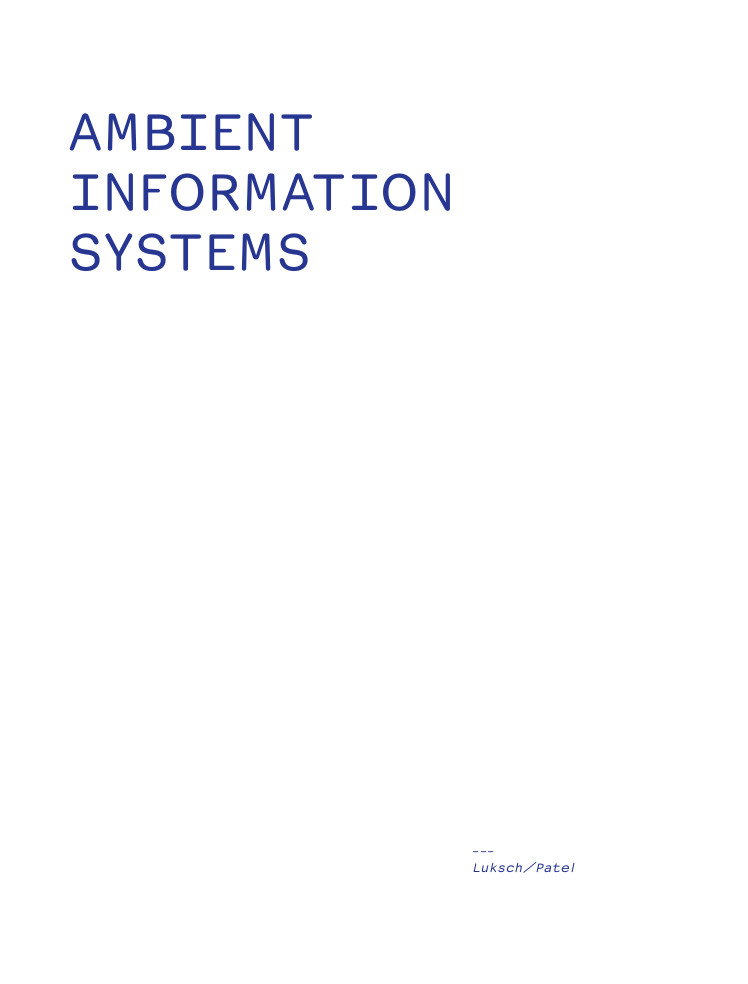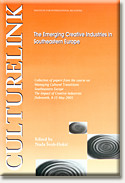Manu Luksch, Mukul Patel (eds.): Ambient Information Systems (2009)
Filed under book | Tags: · activism, art, creative industries, media activism, media art

“The publication elucidates the work of Manu Luksch, Mukul Patel and collaborators as part of the wave of critical art that has emerged alongside the rise of digital networks. Interrogating the social and political transformations of the late 20th/early 21st centuries, their practice bridges art and activism, and recalls aspects of the 1910s-20s avant-garde and 1960s-70s conceptual and systems art.
A major essay by media theorist Armin Medosch situates the work of the London-based artists amidst the rise of the ‘creative industries’ idea, inner-city regeneration, and the dot-com boom. Medosch also discusses critical art in the light of ‘open source culture’ and offers an analysis that draws on systems theory. Other contributors to the book include independent media activist Keiko Sei on the ‘camcorder revolution’ in Burma; policy consultant and writer Naseem Khan on grass-roots regeneration in East London; activist/artist Siraj Izhar on praxis as process; and philosopher/dramaturge Fahim Amir on techno-democracy.”
With contributions by Fahim Amir, Siraj Izhar, Naseem Khan, Armin Medosch, Keiko Sei, and Shane Solanki.
Some texts are in German. Translator: Nicholas Grindell
Published in London, 2009
ISBN 9780955624506
400 pages
PDF (single PDF, added on 2013-11-22)
PDF (PDF chapters)
Rosalind Gill: Technobohemians or the new Cybertariat? New media work in Amsterdam a decade after the web (2007)
Filed under report | Tags: · creative industries, cultural production, culture industry, precariat

Accounts of new media working conditions draw heavily on two polarised stereotypes, veering from techno-utopianism on the one hand, to a vision of webworkers as the new ‘precariat’, victims of neo-liberal economic policies on the other. Heralded from both perspectives as representing the brave new world of work, what is striking is the absence of research on new media workers’ own experiences, particularly in a European context. This INC commissioned research goes beyond contemporary myths to explore how people working in the field experience the pleasures, pressures and challenges of working on the web. Illustrated throughout with quotations from interviews, it examines the different career paths emerging for content-producers in web-based industries, questions the relevance of existing education and training, and highlights the different ways in which people manage and negotiate freelancing, job insecurity, and keeping up to date in a fast-moving field where both software and expectations change rapidly.
The research is based on 35 interviews carried out in Amsterdam in 2005, and contextually draws upon a further 60 interviews with web designers in London and Brighton. The interviews were conducted by Danielle van Diemen and Rosalind Gill.
Interviews: Rosalind Gill and Danielle van Diemen. Copy editing: Ned Rossiter. Design: Léon&Loes, Rotterdam. Network Notebooks editors: Geert Lovink and Sabine Niederer. Printing: Cito Repro, Amsterdam. Publisher: Institute of Network Cultures, Amsterdam
Network Notebooks 01, Institute of Network Cultures, Amsterdam, 2007. ISBN: 978-90-78146-02-5.
More info (publisher)
Comment (0)Nada Švob-Đokić (ed.): The Emerging Creative Industries in Southeastern Europe (2005)
Filed under paper | Tags: · creative industries, culture industry, southeastern europe

The book The Emerging Creative Industries in Southeastern Europe is a collection of papers that resulted from the postgraduate course Managing Cultural Transitions: Southeastern Europe – The Impact of Creative Industries, organized by the Department for Culture and Communication of the Institute for International Relations, Zagreb, and held at the Inter-University Centre in Dubrovnik, 8-15 May 2005. The book gathers contributions by 11 authors who analyze creative industries and cultural cooperation in South East Europe, through three chapters: Creative Industries in Southeastern Europe; Cultural Exchange and Cooperation in Southeastern Europe and Cultural Cooperation Contexts.
The creative industries or, rather, culture industries as they appeared in the Southeastern European countries, stem from the tradition of industrial and market-oriented cultural production taken to be low culture or even kitsch cultural production, undermined during the times of socialism. In the transition period these industries became more associated with the ideas of modernization and technological progress, and strongly prompted by imports of cultural consumerism based on pop cultural products. It became clearly visible that small-scale cultural industries and productions might be both economically and culturally reasonable if supported by regionalist ideas and intra-regional cultural cooperation, which might, perhaps, establish links among small and very diverse Southeastern European cultures. However, the influence of large transnational corporations, which are turning the region into a part of the global cultural market, has not yet been undermined.
In The Emerging Creative Industries in Southeastern Europe authors from the region add a new dimension to this discussion and show how the Southeast European transitional societies, at best “mixed societies” undergoing different types of the modernization process, may react to challenges relating to the development of creative industries and creative economies. The authors clearly stress that in spite of numerous commonalities, the differences between countries in the region, and also within them, may still produce very different reactions to the challenge of creative industries and the markets they may be cultivating.
Collection of papers from the course
Managing Cultural Transitions: Southeastern Europe – The Impact of Creative Industries
Inter-University Centre, Dubrovnik, 8 – 15 May 2005
Edited by Nada Švob-Đokić
Culturelink Joint Publications Series No. 8
Institute for International Relations
Zagreb, 2005
ISBN 953-6096-37-4

